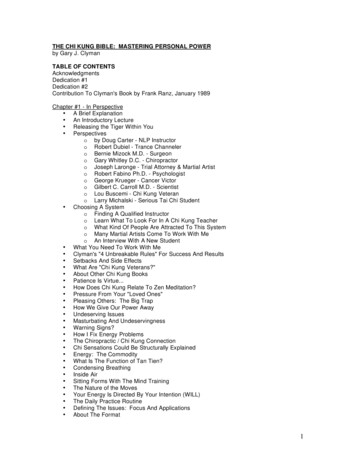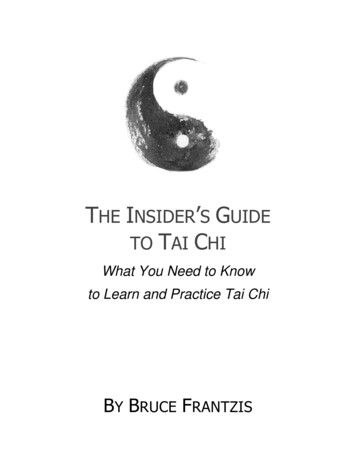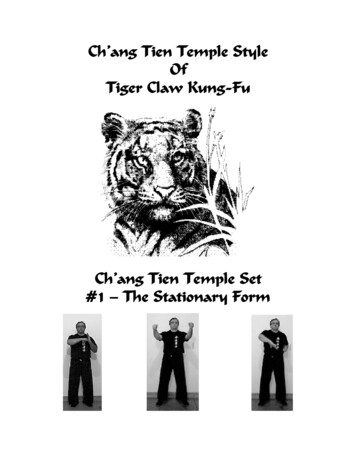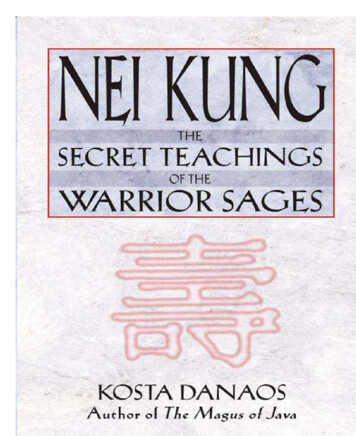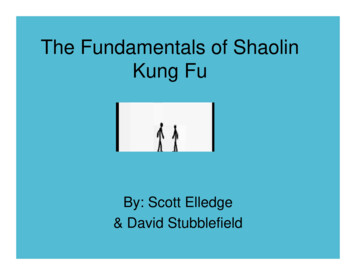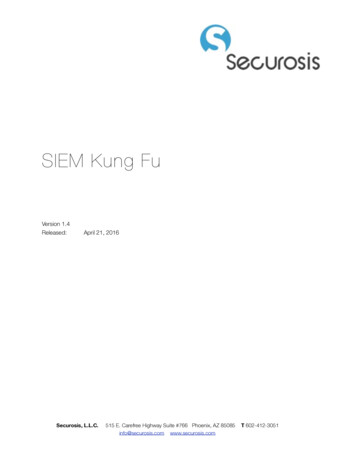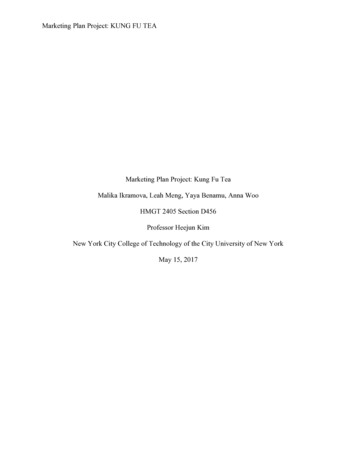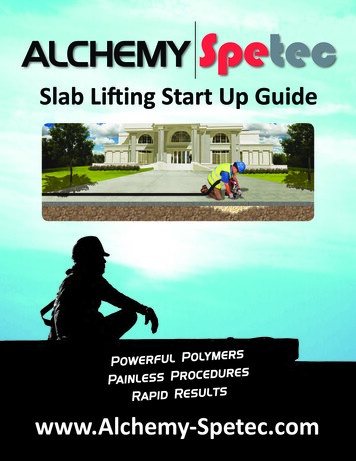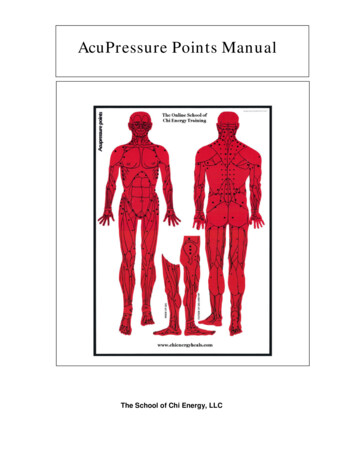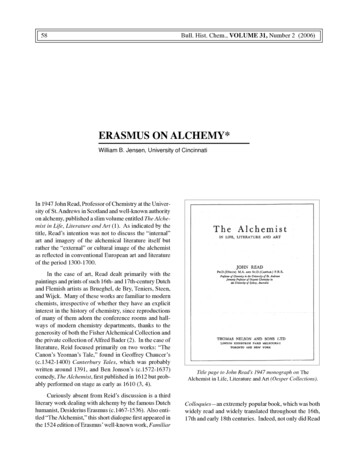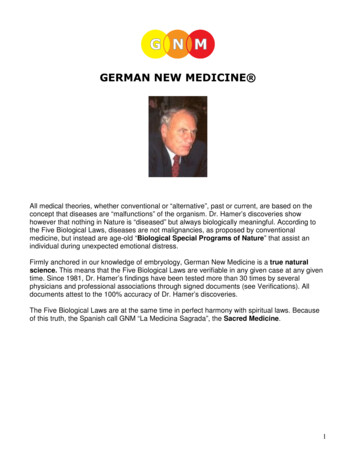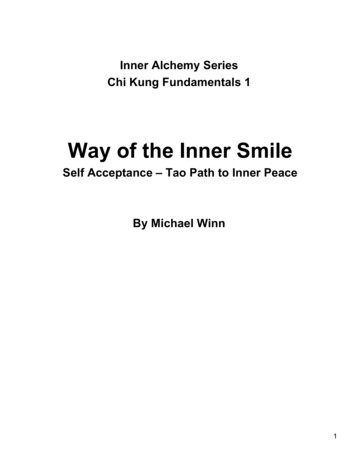
Transcription
Inner Alchemy SeriesChi Kung Fundamentals 1Way of the Inner SmileSelf Acceptance – Tao Path to Inner PeaceBy Michael Winn1
Cambodian Goddess with beatific Inner SmileContemporary teak, Dao Mountain Retreat CenterNote: This short book is one segment of my Tao Home Study audio course Chi KungFundamentals #1, but expanded. The rest of audio course #1 covers Tao FiveElements theory and practice: Five Animals Play China’s oldest shamanic chi kung(qigong) form, as well as the Six Healing Sounds.Modern Chinese pinyin spelling is used (Daoism vs. Taoism), except for a few keywords now part of English (Tao, Chi Kung instead of qigong, chi instead of qi. Tao ispronounced “dao”. Chi is pronounced “chee”).2
AcknowledgementsSpecial deep gratitude to Mantak Chia, who inspired me to explorethe path of Tao. I especially thank him for sharing a transmission ofDaoist Hermit One Cloud’s simple smiling presence. Thanks to manyother spiritual teachers in this lifetime, especially my Mother andFather, whose inner smile at my moment of birth was so precious.Thanks to my many other Tao masters, and the countlessgenerations of Tao adepts before them. To the chi kung and inneralchemy masters going back thousands of years into pre-history, forsharing their smiling “aha” – their discovery on how to best cultivatechi while staying grounded in the body.Eternal gratitude to my partner Joyce Gayheart for being such abeautiful heartfelt smiling presence in my life. Thanks to all my HealingTao and Universal Tao colleagues and students who have devotedthemselves to spreading their smiling presence in the humancommunity.Deep appreciation to the Tao Immortals, the Earth, Sun, Moon,Planet and Star beings for their gentle smiling guidance on my journeyinto the Great Within and the Great Beyond.I offer Supreme Ultimate thanks to the Tao, for making the InnerSmile the true response to getting the Cosmic Joke.3
Table of ContentsFor instant digital scrolling to any item in the Table of Contents, click on the "Bookmarks" tabin Adobe's WINDOW menu bar. To find favorite photographs, click on "Thumbnail" in theWINDOW menu.About the AuthorForeward: Inner Smile – Root of the Rootby Mantak ChiaIntroduction: What is the Inner Smile?The Smiling Inner Heart of our Energy BodyChapter 11. The Sages Way to Unfold Tao: Inner Smile Mapping Our Body-Mind’s Energetic Patterns Our Inner Family of Biological Intelligences Inner Smile Deepens other Tao Practices Sexual Tension of Becoming vs. Tai Chi Harmony of Being Can the Inner Smile change real life situations?Chapter 22. Key to the Inner Smile: Self-Acceptance Positive Ego, Negative Ego, Neutral Ego St. Francis of Assisi: Punishing the un-Holy Body Outer Acceptance vs. Inner Acceptance, Outer Smile vs. Inner Smile Receptive Yin Smile, Projective Yang Smile Chi Dissolving Process Purifies Mind & Emotions4
Chapter 33. Smile Softly to Overcome the Hard Smile links Inner Heart to Original Spirit Neutral Smile of Acceptance vs. Acts of Love Smiling is Non-Dualism Made Simple What does “presence” mean in smiling practice?Chapter 44. Overview of Inner Smile Practice Simple Guided Smile as “warmup” Over View of Body-Smiling Pathways: The Three Brains The Five Vital Organ Spirits The Spine & Nervous System The Six Bowels & Sexual Organs The Cells, Connective Tissue, Skin & Bones Inner Smile is Its Own Reward Taoist Flower Essences for the EmotionsChapter 55. Guided Inner Smile MeditationPreparation: Actualize a Receptive Natural SpaceUse Positive Memory: Supercharge your Mind Space5
Yin Practice:Step 1: Smile into the three brainsStep 2: Smile to the heart and vital organ spiritsStep 3: Smile to the spine & nervous systemStep 4: Smile, swallow to bowels & sexual organsStep 5: Smile to bones, blood, flesh, & cellsStep 6a: Smile, dissolve your entire physical bodyStep 6b: Smile, dissolve beyond the bodyYang Practice:Smile into your AuraSmile into the RoomSmile to a FriendSmile to a Difficult RelationshipSmile to your Local CommunitySmile to Planet EarthSmile to Sun and StarsSmile to the Dark Ocean Beyond the StarsAllow Yourself to Feel the Return Smiling WaveGather the Wave of Smiling Chi inside your BodyChapter 66. Question & Answer1. How long do I practice Inner Smile at one sitting?2. Can Inner Smile help couples having difficulties?6
3. What do you do if you just feel bored while smiling?4. I have struggled with boredom and depression for a long time. DoI need to try harder for a breakthrough?5. What’s the difference between Inner Smile as “Water & Fire”dissolving and Tao Water-only dissolving methods?6. Does Lao Tzu mention the Inner Smile?Chapter 7: Conclusion7. Inner Smile as Path to EnlightenmentTao Cosmology: Unfolding the Original TrinityThe Confusion of Spoken Language– Spiritual Being vs. Bodily BecomingSmiling Chi Flow as the Silent Language of NatureSmiling Builds Trust in Original Substance-BodyThe Great Secret of Internal AlchemyAppendix OneChi Kung Fundamentals #1 & 2 Homestudy Course(discount offer). Testimonials on improved health.Appendix TwoComplete List: Healing Tao Home Study audio-video courses inrecommended sequence.Appendix ThreePoem “Smile” by Barbara Hauck7
About the AuthorMichael Winn in inner smiling state(Photo taken after deep meditation).Michael Winn was born in San Francisco’s Presidio in 1951, next tothe towers of the Golden Gate Bridge. According to Tao master Ni HuaChing’s astrology reading, the Golden Gate, a symbolic bridge betweenAsia and America, shaped his destiny. Chinese astrology typicallylooks at earthly feng shui influences as well as planetary forces.8
Winn graduated from Dartmouth College in 1973 as a Senior Fellowin Russian and Comparative Literature. He has visited 90 countries, amodern wandering Daoist (Taoist). His first job was as a Grand Canyonwhite water guide, which led to him running a 1981 rafting expeditionto North Yemen for National Geographic. Later he participated on afirst descent of the upper gorges of the Mekong River in China.His first wife was Ethiopian, Shamai (Candlelight) Abebe. Aftergetting fired from a New York publishing job for being “too creative”,he succeeded as a war correspondent and photojournalist in Africa.His first break came in 1978 when he was thrown into prison inEthiopia during its civil war and got a scoop on the Soviets running itstorture system.He later opened Abyssinia Ethiopian Restaurant in New York’s Sohoin 1980, and ran it for 20 years as a side business. During this periodWinn, a “goy” or gentile, organized and operated an “undergroundrailway” that smuggled over twenty white Jewish missions intoEthiopia to bring medicine and support for a struggling tribe of BlackJews (falasha). It ultimately led to their mass exodus back to theirpromised land in Israel.For one of his stories he locked himself inside the Great Pyramidovernight. He hitchhiked across the Sahara desert for another story. In1983 and 1985 he spent a total of five months following Marco Polo’sroute over the Hindu Kush mountains of Afghanistan and Pakistan and4000 miles overland across China’s vast western deserts and along thelength of the Great Wall. This was near the beginning of a long loveaffair with the Tao. He met his second and current wife, JoyceGayheart, at a Healing Tao retreat in 1983.He eventually switched from outer travel adventure to inner spiritualadventure. During his wanderings, Winn began exploring differentesoteric systems, mostly to “demystify” for himself the ancientMystery Schools. He hoped to find the most effective methods ofimproving health and refining spiritual awareness. Besides variousDaoist/Taoist schools, he studied tantric kundalini yoga, kriya yoga,dzogchen (Bon), Tibetan Buddhist vajrayana practices, and Atlantean9
internal alchemy (original, pre-Egyptian Kaballah). He will release abook on this latter topic shortly.He took many teachings and initiations with the Dalai Lama, andworked closely for years with Paramhamsa Hariharananda (successorin India to Yogananda), and edited his Bhagavad Gita in the Light ofKriya Yoga. All this shaped his spiritual practice, but he alwaysreturned to his roots in the Tao because of its natural simplicity andpracticality in honoring the body.He tested over sixty different chi kung (qigong) forms and Taomeditation systems. He studied with dozens of different masters, oftenonly to get one superb movement or tiny but valuable insight they had.Master T.K. Shih lived with him for two years. He studied pakua changwith B.K. Frantzis and edited his first book, as well as several booksfor Tao master Ni Hua Ching. His Wu style tai chi teacher wasgrandmaster Ed Yu in New York’s Chinatown (Mantak Chia's tai chiteacher). He studied Northern Wu style with David Dolbear (USA goldmedalist) and his master Liu Jiang Chang in Beijing.Winn has traveled to China seven times, to meditate in the caves ofits holy Tao mountains and sacred places, and to study medical chikung in Beijing hospitals with the World Academic Medical QigongSociety. Each year he invites top masters to teach at Healing TaoUniversity such as Li Jun Feng and Wang Yan. He has been anorganizer of the National Qigong Annual Conference since its inceptionin 1997. He leads regular trips to China to open the doorway betweenWestern and Chinese internal alchemy adepts of the Tao.Other worldly doings (for nervous types who trust resumes): 25 years experience in teaching subtle energy methods, which led toa medical chi kung therapy practice. Past President of the National Qigong (Chi Kung) Association for twoterms. The umbrella organization for all chi kung schools, teachers,healers, & practitioners in the U.S. (www.nqa.org)10
Founder and Director of Healing Tao University summer retreatprogram (campus at Dao Mountain in New York's Catskill Mountains).The largest Tao arts program in the west, with a faculty of 20 mastersand 30 retreats. Writer-editor of seven of Mantak Chia's books. Best known as coauthor of Taoist Secrets of Love: Cultivating Male Sexual Energy. Past Chairman of Healing Tao Instructors Association of theAmericas for 9 years. One of the original Senior Instructors thatlaunched the Healing Tao, which globally has certified over 1000instructors and brought the Tao teachings to hundreds of thousands ofpeople. Written numerous articles in Qi Journal, Empty Vessel and othernational publications. Co-author of Qigong Therapy chapter inPhysicians Guide to Complementary & Alternative Medicine. Produced ten Tao Home Study audio-video courses that summarizethe essence of his discoveries over the last 25 years.Winn reports that far more important than any of his worldly doingsand wanderings is his practice of the Inner Smile – the path of the soulaccepting its body and destiny. He feels his greatest accomplishmentwill be to share with the reader the simple and profound joy of thesoul’s inner smile.11
The author, wearing a smiling sun-moon image, “holding up” the Temple ofHeaven in Beijing. This 14th century Daoist temple, built for the Emperor topray to the Tao, is one of the most sacred in China. The triple roofsymbolizes the Daoist notion of Original Trinity and the three levels ofheaven.12
ForewardInner Smile: Root of the RootBy Mantak ChiaThe Tao science of chi cultivation is so huge. It is easy to get lost init. Taoists spent thousands of years developing so many different wayto refine human chi using chi kung and meditation. They took thescience of healing and medicine to new depth, had hundreds of martialarts systems, found the best way to build houses with good feng shui,and figured out how to bury the dead so the ancestral chi is mostbeneficial. They developed high systems of Tao philosophy, ethics,sexology, herbology, divination and many other things.But some things are more important than others. So I am very gladthat Michael Winn chose to write more deeply about the Inner Smile,because it is so close to the root of the root. By this I mean the InnerSmile is so close to the root of inner alchemy, and inner alchemy is theroot of all the other Tao systems, even the I Ching.Lao Tzu says that the man of knowledge acquires something neweveryday, and the man of Tao lets go of something new every day. Theman who practices the Inner Smile is a man of Tao. I feel Michael Winnis both a man of knowledge and a man of Tao. His writing will helppeople to understand why the Inner Smile is so important, and how itsimplifies so many other good and useful practices.I have known Michael Winn for more than twenty years, so I knowhow deeply committed he is to Tao. I consider him one of the bestwriters on Tao in the West. I am grateful to him for his skillful writing tohelp explain to Westerners the practical science of Tao subtle energy.People used to think Tao was just an interesting intellectual13
philosophy. Now they begin to realize it is a very deep spiritualscience.The Way of the Inner Smile takes the theory and the practice to ahigher level of understanding. It has many new insights, and revealshow his own teaching skill has matured. He has taught manyWesterners and figured out how their minds and bodies can mosteasily absorb Tao methods. He is able to explain the connectionbetween biology, Tao psychology of body-spirits, and inner alchemicaltransformation of the human soul.His focus on unconditional self-acceptance is a modern way ofexpressing traditional Tao practice of utter openness to life. It is anopenness that must begin with the body.Please enjoy this journey deep into the land of Inner Smiles!Mantak ChiaTao Garden, ThailandMay 200314
IntroductionWhat is the Inner Smile?Man without smiling face should not open a shop.- Chinese ProverbThe Inner Smile is a simple, effortless Daoist (Taoist) meditation onhow to live with an open heart. You can practice it sitting quietly, orwhile engaged in everyday activities. The Inner Smile challenges us, ina series of “smiling baby steps”, to u
Western and Chinese internal alchemy adepts of the Tao. Other worldly doings (for nervous types who trust resumes): 25 years experience in teaching subtle energy methods, which led to a medical chi kung therapy practice. Past President of the National Qigong (Chi Kung) Association for two terms. The umbrella organization for all chi kung schools, teachers, healers, & practitioners in .
